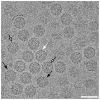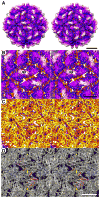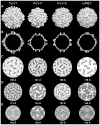Structure of Fusarium poae virus 1 shows conserved and variable elements of partitivirus capsids and evolutionary relationships to picobirnavirus
- PMID: 20599510
- PMCID: PMC3664192
- DOI: 10.1016/j.jsb.2010.06.022
Structure of Fusarium poae virus 1 shows conserved and variable elements of partitivirus capsids and evolutionary relationships to picobirnavirus
Abstract
Filamentous fungus Fusarium poae is a worldwide cause of the economically important disease Fusarium head blight of cereal grains. The fungus is itself commonly infected with a bisegmented dsRNA virus from the family Partitiviridae. For this study, we determined the structure of partitivirus Fusarium poae virus 1 (FpV1) to a resolution of 5.6Å or better by electron cryomicroscopy and three-dimensional image reconstruction. The main structural features of FpV1 are consistent with those of two other fungal partitiviruses for which high-resolution structures have been recently reported. These shared features include a 120-subunit T=1 capsid comprising 60 quasisymmetrical capsid protein dimers with both shell and protruding domains. Distinguishing features are evident throughout the FpV1 capsid, however, consistent with its more massive subunits and its greater phylogenetic divergence relative to the other two structurally characterized partitiviruses. These results broaden our understanding of conserved and variable elements of fungal partitivirus structure, as well as that of vertebrate picobirnavirus, and support the suggestion that a phylogenetic subcluster of partitiviruses closely related to FpV1 should constitute a separate taxonomic genus.
Copyright © 2010 Elsevier Inc. All rights reserved.
Figures






Similar articles
-
Cryo-electron Microscopy Structure, Assembly, and Mechanics Show Morphogenesis and Evolution of Human Picobirnavirus.J Virol. 2020 Nov 23;94(24):e01542-20. doi: 10.1128/JVI.01542-20. Print 2020 Nov 23. J Virol. 2020. PMID: 32938763 Free PMC article.
-
Partitivirus structure reveals a 120-subunit, helix-rich capsid with distinctive surface arches formed by quasisymmetric coat-protein dimers.Structure. 2008 May;16(5):776-86. doi: 10.1016/j.str.2008.02.014. Structure. 2008. PMID: 18462682 Free PMC article.
-
Backbone trace of partitivirus capsid protein from electron cryomicroscopy and homology modeling.Biophys J. 2010 Jul 21;99(2):685-94. doi: 10.1016/j.bpj.2010.04.058. Biophys J. 2010. PMID: 20643089 Free PMC article.
-
3D structures of fungal partitiviruses.Adv Virus Res. 2013;86:59-85. doi: 10.1016/B978-0-12-394315-6.00003-9. Adv Virus Res. 2013. PMID: 23498903 Free PMC article. Review.
-
Taxonomic reorganization of family Partitiviridae and other recent progress in partitivirus research.Virus Res. 2014 Aug 8;188:128-41. doi: 10.1016/j.virusres.2014.04.007. Epub 2014 Apr 21. Virus Res. 2014. PMID: 24768846 Review.
Cited by
-
Animal picobirnavirus.Virusdisease. 2014;25(2):223-38. doi: 10.1007/s13337-014-0207-y. Epub 2014 Apr 2. Virusdisease. 2014. PMID: 25674589 Free PMC article. Review.
-
Cryo-electron Microscopy Structure, Assembly, and Mechanics Show Morphogenesis and Evolution of Human Picobirnavirus.J Virol. 2020 Nov 23;94(24):e01542-20. doi: 10.1128/JVI.01542-20. Print 2020 Nov 23. J Virol. 2020. PMID: 32938763 Free PMC article.
-
Three-dimensional reconstruction of icosahedral particles from single micrographs in real time at the microscope.J Struct Biol. 2013 Sep;183(3):329-341. doi: 10.1016/j.jsb.2013.07.007. Epub 2013 Jul 25. J Struct Biol. 2013. PMID: 23891839 Free PMC article.
-
Extending the Host Range of Fusarium Poae Virus 1 from Fusarium poae to other Fusarium Species in the Field.Viruses. 2022 Oct 13;14(10):2246. doi: 10.3390/v14102246. Viruses. 2022. PMID: 36298801 Free PMC article.
-
Novel viruses of the family Partitiviridae discovered in Saccharomyces cerevisiae.PLoS Pathog. 2023 Jun 7;19(6):e1011418. doi: 10.1371/journal.ppat.1011418. eCollection 2023 Jun. PLoS Pathog. 2023. PMID: 37285383 Free PMC article.
References
-
- Boccardo G, Candresse T. Complete sequence of the RNA1 of an isolate of White clover cryptic virus 1, type species of the genus Alphacryptovirus. Arch Virol. 2005;150:399–402. - PubMed
-
- Bozarth RF, Wood HA, Mandelbrot A. The Penicillium stoloniferum virus complex: two similar double-stranded RNA virus-like particles in a single cell. Virology. 1971;45:516–523. - PubMed
-
- Buck KW, Kempson-Jones GF. Biophysical properties of Penicillium stoloniferum virus S. J. Gen. Virol. 1973;18:223–235. - PubMed
Publication types
MeSH terms
Grants and funding
LinkOut - more resources
Full Text Sources

